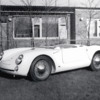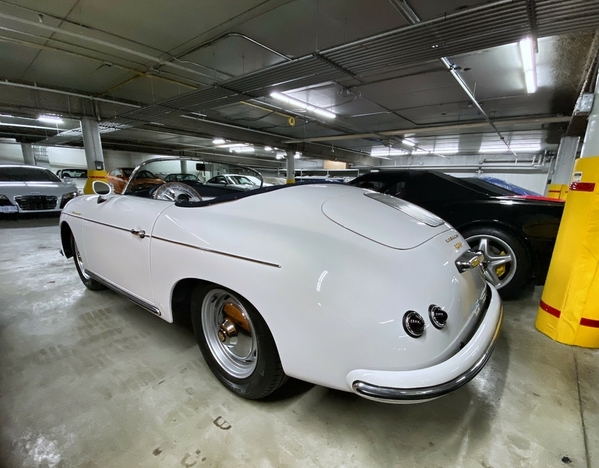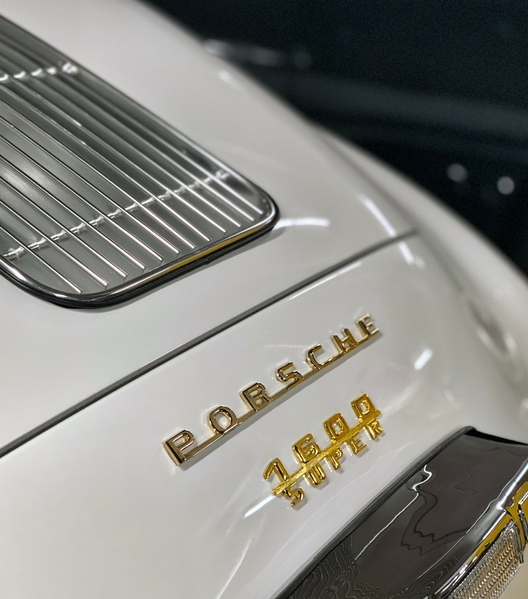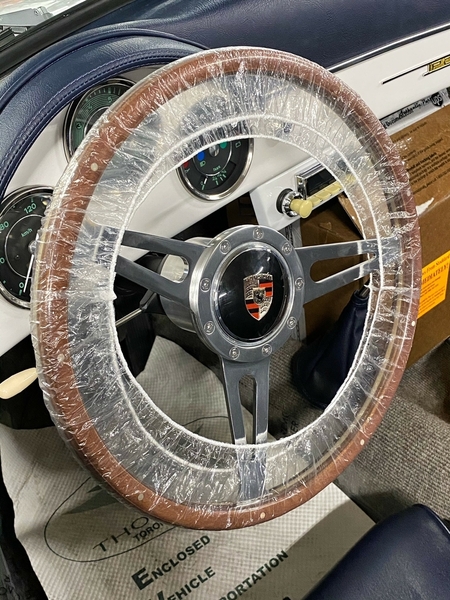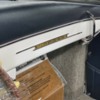You can bypass the frame by installing a pipe directly from the heat exchangers to the front hoses. Much more airflow and more heat. It all so is noisy. If the outside temp is near freezing the engine will not get hot enough to produce heat. Original VW design worked because the engines were small and had no external filter or cooling. Likewise they only had 2.5 quarts of oil. Those engines got warm in cold weather.
@Stan Galat posted:Your new engine will need "broken in". Change the oil after the first 300 mi. Thereafter, change your oil every year or every 3000 mi., whichever comes first.
Thanks! I am hoping that car comes with a user manual, but you never know. Do I need to baby it in the beginning or just drive normal once it warms up?
Probably the most important thing is to not lug the engine.
Folks on the Porsche forums swear by actually running it hard (full throttle runs and downshifting to slow the car down) for the first 300 miles to break in the rings. I've done this on several air cooled engines with no noticable downside, but others may have different thoughts.
Otherwise, just let it warm up, don't lug it and have fun!
I've tried a number of ways to get the best heat out of a heater box, the shortest routing produced the most heat. I ran a short hose duct from the heater box to the L & R forward vertical portions of the rear seat....It's not the " right way " to do it but made some seriously hot heat~
@Gordon Nichols posted:The three alternatives to stock VW/Speedster replica heat are:
1. No heat at all (because we sometimes don't install the heater units on the exhaust pipes) and
2. Using the stock or modified heater units on the engines or;
3. Restoring an old (pre-1960 - 1980) VW-style gasoline-powered heater. These things put out GOBS of heat but only had two operational modes: Scorch the top of your knees right below the heat outlet or..... Off.
The originals were not automatic at all and required a lot of operator intervention, turning the switch on and off to control cockpit heat level. I've modified mine such that I can dial the heat output level up and down with a dash knob, but AFAIK mine is the only one that does that - more modern versions have this feature as well.
Two photos: The installed heater in the nose of the car and the dash controller under the car radio. It's a lot more involved than the engine heater boxes:
Option 4: Pony up a "fistful of dollars" and get a MODERN Webasto or Espar gas heater. They are smaller(same heat output), electronically controlled(reliable and safe), and VARIABLE output(come that way, with, like, a knob). My Webasto cost less than $1000 installed WITH defrost. Espars are about $1500 for just the heater.
The newer heaters are a bit of work to install, but they work and work well. They aren't that hard to work with.
Output does not depend on engine warmth or speed. And no heater boxes, if you are a performance engine guy(better exhaust).
What Model Webasto did you get for your car?
Webasto Airtop 2000 STC. Output is 7000-8000 btu/hr. Gasoline consumption is about a gallon in a day, it works out to less than 6 ounces per hour. The unit is 5" square and 12" long. It bolts through a bulkhead. Fuel, fuel pump power, combustion intake and exhaust go through the bulkhead with a rubber gasket. The wire harness is pre-built and can be shortened or excess coiled up. It comes with an on-off rotary control.
I paid about $700, but bought some heat outlets, plastic adapters(a T and a Y), large diameter hose for the heat outlets, and small diameter hose for the defroster outlets. I also purchased some heat sleeving for the combustion exhaust hose and some stick-on heat shield for under the gas tank. I made a spring-loaded flapper to turn the defrost air on and off. It added up to about $1000 total.
I purchased a brass T to cut into my fuel supply after my pre-filter to go the heater fuel pump. The pump is mounted by the front beam and is gravity fed.
Carey Hines provided me with his proprietary aluminum dash vent trim. I used small Shop-Vac outlets to feed the windshield vents.
If you end up doing one of these heaters, make sure you don't create a heat loop. That is to say make sure your cold air intake is far away from the heater outlets. My intake is from the rocker panel on my Spyder, about 4-5 feet away from the outlets.
They are a bit involved, but it's all pretty straight-forward if you're familiar with custom auto installation. If you have any stereo or alarm experience that would be a plus.
Mine came from the Czech Republic. This is from Russia, but with $120 shipping it "rings the bell" at $700:
https://www.ebay.com/itm/12445...LEAQYAiABEgLh8PD_BwE
I do not know this person/seller. Just noting that these are available.
Funny story: When I was in high school, my older brother’s best friend bought a 356 cab. Being January in Utah, the only proper thing to do was drop the top so all three of us would fit and go for a ride.
About 10 minutes in, we smell burning rubber so we pull over, which is when I discover the sole of my Fred Perry’s are smoking and just about to ignite, having had my foot jammed up against the gas heat duct on the floorboard. ![]()
@DannyP posted:Webasto Airtop 2000 STC. Output is 7000-8000 btu/hr. Gasoline consumption is about a gallon in a day, it works out to less than 6 ounces per hour. The unit is 5" square and 12" long. It bolts through a bulkhead. Fuel, fuel pump power, combustion intake and exhaust go through the bulkhead with a rubber gasket. The wire harness is pre-built and can be shortened or excess coiled up. It comes with an on-off rotary control.
I paid about $700, but bought some heat outlets, plastic adapters(a T and a Y), large diameter hose for the heat outlets, and small diameter hose for the defroster outlets. I also purchased some heat sleeving for the combustion exhaust hose and some stick-on heat shield for under the gas tank. I made a spring-loaded flapper to turn the defrost air on and off. It added up to about $1000 total.
I purchased a brass T to cut into my fuel supply after my pre-filter to go the heater fuel pump. The pump is mounted by the front beam and is gravity fed.
Carey Hines provided me with his proprietary aluminum dash vent trim. I used small Shop-Vac outlets to feed the windshield vents.
If you end up doing one of these heaters, make sure you don't create a heat loop. That is to say make sure your cold air intake is far away from the heater outlets. My intake is from the rocker panel on my Spyder, about 4-5 feet away from the outlets.
They are a bit involved, but it's all pretty straight-forward if you're familiar with custom auto installation. If you have any stereo or alarm experience that would be a plus.
Mine came from the Czech Republic. This is from Russia, but with $120 shipping it "rings the bell" at $700:
https://www.ebay.com/itm/12445...LEAQYAiABEgLh8PD_BwE
I do not know this person/seller. Just noting that these are available.
Thanks for the info on the heater, I’m going to look into using it on my 356 (a next year project).
Far be it for me to tell you what to do but if it were me, I’d look for an operational, rebuilt period Webasto or Eberspaecher heater to put in an original 356.
I wish, I have a CMC replica....appreciate the concern....Thanks
maybe a dumb question, i notice a lot her "CMC". With the CMC, to you mean Vintage Motorcars?
California Motor Carriage formerly of Miami, aka Fiberfab. They’ve been out of business for years.
@Larry Scislowicz posted:I wish, I have a CMC replica....appreciate the concern....Thanks
That makes sense. I’d be more inclined to drive a speedster in the winter, too.
@dlearl476 posted:California Motor Carriage formerly of Miami, aka Fiberfab. They’ve been out of business for years.
Just a small (minded), pedantic correction: Classic Motor Carriages.
Quick question, is it safe to drill into the fibreglass body to install trim? Would this cause cracks?
@KenTO posted:Quick question, is it safe to drill into the fibreglass body to install trim? Would this cause cracks?
It is safe. Double check your marks to make sure they're in the right place, then use a very small drill bit to start the hole. To start drilling, run the drill in reverse and the small bit won't move off of your mark. Once you've opened up a divot with the drill in reverse, switch it into normal mode and drill a hole with the small bit to make a pilot hole. Then you can use the bit size you'll need for the trim and it will follow the pilot hole without moving across the paint.
Probably more info than you need, but it might help someone who hasn't done it.
Also, I prefer these “Bullet” style drill bits over regular drill bits for drilling fiberglass. They kind of have a pilot bit built in, and the flutes are more mill bit-like so it makes for a cleaner edge.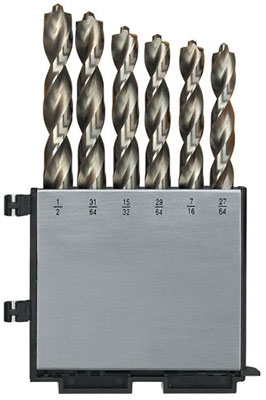
And if you tape the area where you’re going to drill, it makes it easier to mark as well as keeping the corner of the hole from cracking off.
Attachments
Do like Mike says above. You can use super glue or clear nail polish to seal the fiberglass. I prefer the nail polish, sometimes super glue will craze making white residue on you paint. Or you can just use touch-up paint. Use blue tape.
When I put emblems on, I trace them on a manila folder. Then I cut the trace out to line them up on the car. Lets you line the emblem up straight and the holes in the right place.
smart! Thanks for the advice!
Another question about the car, it’s a Vintage Motorsports model with 100 km on the clock, as I am not mechanically inclined (I work on people) how good is the car “out of the box?” Are they tested and tuned going out the door or do I need a once over by a mechanic before I start enjoying her.
Ken, well it is a little bit alike, you have to go through all the systems to make sure they are all ok. Even a new build on a car can have Carb issues, suspension issues, Motor issues, alignment etc. then some small stuff like rash or other that you can live with so long as the urticaria doesn't affect you too much. Here we call it the madness, you'll understand it in the end.
Honestly, these cars are NOT DAILY Drivers out of the box of the Manufacturer just trying to bring a bit of info so that your not dissapointed. Ray
BTW, where are you located again in the GTA?
North York. I’m hoping the dealer will sort out any issues in the beginning. Peter’s Garage is closed due to Covid, they have experience with air-cooled bugs and have reasonable rates. I’ll stick to driving it around the neighborhood until I can get a once over by a mechanic.
DANG, Ken! That looks awesome! I like the Porsche nipple hubcaps against the painted wheels. Nice set up. Here's wishing you MANY miles of top-down cruising enjoyment! ![]()
Congratulations!
Congrats, very nicely done.
Hey guys, after a long drive today, I noticed 2 problems:
1. I have to hold the steering wheel at a 45 degree angle right for the car to go straight, with the steering wheel strait it looks like the right front wheel is turned out, needs alignment?
2. When I use the turn signal the horn goes off, any advice to fix this? It looks like if I push it away and turn it does not, but towards me or neutral it does.
Thanks from a newbie.
ur steering wheel is on crooked?loosen it and move it over # grooves
horn fix, dont use turn signal
@KenTO wrote:
"1. I have to hold the steering wheel at a 45 degree angle right for the car to go straight, with the steering wheel strait it looks like the right front wheel is turned out, needs alignment?
2. When I use the turn signal the horn goes off, any advice to fix this? It looks like if I push it away and turn it does not, but towards me or neutral it does."
Way back up above you also mentioned that you don't work on cars, you work on people so this is detailed for you or your chosen mechanic.
Just out of curiosity, what type of people work do you do? I used to deal with computers - They were probably easier to deal with. ![]()
Ken: I think both of these are related and to be safe you should have a 4-wheel alignment done on the car just to know everything is tight and safe. Peace of mind is a wonderful thing.
So for either you or the trusted mechanic that you're gonna find (print this and show it to him/her), maybe whomever added that beautiful steering wheel didn't quite know what they were doing with the directional lever/switch just below the steering wheel on the steering column. The switch/lever has to be installed just so and tightened properly and any wires in there tucked away so they don't contact anything. Also, the steering wheel should be centered in the steering range, left to right. This post will tell you how. All of this is outlined in a Bentley VW Service Manual which you should buy:
https://www.amazon.com/Volkswa...620856104&sr=8-1
It's done by turning the wheel all the way to the right and note the position, then all the way to the left, count the turns on the wheel right to left and note the position, then go back and get it as close to the exact middle between left and right as you can and leave it there ( don't worry about which way it's pointed - We're gonna fix that next).
Remove the steering wheel and place it aside but do so by removing the big nut in the middle, down behind the horn button, not by removing the 6 screws around the center. This gives you access to the directional lever behind it so you can see what's going on and correct what's wrong. I suspect it's loose, but there may be more things to discover and sort out. Look for loose wires or wires that have bare copper (no insulation) really close to something metal and figure out how to insulate them. Also, with the wheel off you can find the horn wire and see if it's touching anything else and correct that, too.
Back to the steering wheel - There is a hub on the back of the wheel about the diameter of a beer can and almost as long. That is an adapter between the steering shaft (the big rod with serrated teeth on the top that goes through the middle of the steering column) and your steering wheel. On the bottom of that adapter is a big, curved tab that actuates the directional lever release feature. When you turn a corner and have the Blinkah on (that Bahsten-speak for directional), that tab cancels it and makes it go off - simple as that, BUT it has to be in the right orientation (centered) in order for the system to work properly for left or right turn so there is a relationship between the directional switch cancel lever, the adapter tab and the steering wheel that has to all be in sync.
Looking at the bare directional switch should show you where that tab wants to be to cancel the Blinkahs each time. It comes around as you turn the wheel and contacts a little lever in the switch extended by pushing the directional lever up or down and the tab pushes it back to a neutral position and shuts off the blinkah. Where it is now in relation to a straight steering wheel might not be where it wants to be for the Blinkahs to cancel. If not, then remove the steering wheel from the adapter and rotate it to where the cancel tab is going to work, re-assemble the adapter to the steering wheel and then re-assemble the steering wheel/adapter to the steering shaft but this time, get the steering wheel centered as it should be going straight (remember that switch/adapter/wheel relationship).
Once all that is done, one of two things will happen: Either it will go down the road straight with the steering wheel straight, or it won't. If it does AND the Blinkahs cancel as they should when taking a corner, then go have yourself a beer. If the car goes straight but the steering wheel is a little cocked to one side, you an either repeat some of the above by removing it and rotating it on the steering shaft a tooth or two to where it needs to be to go straight, OR take it in for a front end alignment. If you do that, before your alignment, order a pair of caster shims from CB Performance:
https://www.cbperformance.com/product-p/6215.htm
and bring them along to the alignment place. Ask them to set it up as a 1970 VW Beetle BUT set the caster to 5º - 6º NOT the usual 3º. That will account for the lowered suspension and make the car more stable on a highway. They will need the caster shims you bring along (they probably won't have them in stock) if they need to reset the caster for you.
That should do it for you, and remember:
Attachments
I'm an emergency doctor, graduated in '95. This sounds doable but pictures would help. I've ordered the manual but won't be delivered until early June.
Ken, the VW Type I set up is not very complicated and Peter your mechanic should be able to set the wheel by finding the center point of the steering box as our Bostonian friend has said. Then re & Re the wheel. and fix the horn ring and signal light issue at the same time. It is standard older vw stuff. ![]() You'll get it sorted.
You'll get it sorted. ![]()
Three times in my life I have been a guest of an ER or Trauma center. Once was pretty bad (pickup truck versus bicycle rider) and it might have been touch and go were it not for an amazing staff of quick thinking, thoroughly trained people.
A big THANK YOU for what you do.
You guys and EMTs are ROCK STARS!
And don't apologize for your perceived lack of mechanical abilities. Ralph Salzer is an Orthopaedic Surgeon in Beaufort, SC. He is also a classic car collector and he used to say that about himself, too ("Boy, I really envy you guys who know how to work on these cars, blah, blah, blah").
Ralph has a 1950's Studebaker sedan that needed the heater air plenum replaced - The original was made from treated cardboard and disintegrated over time. Couldn't find a new one anywhere. Later on, Ralph shows up at a show with a brand new plenum installed in his car. When asked where he got it he said, "I made it!"
When pressed further, he told us that he made the new plenum out of fiberglass leg cast material, shaped over the old original plenum as best he could. It looked and worked fabulous. He (and you) have the same abilities we car guys have, just re-directed to what you've chosen to do. A car bears many similarities to a human body, if you look for them. Plus, it's sometimes fun to get your hands dirty with something that no one is relying on to keep living.
Good luck, and keep asking questions. (And I was (and still am) a computer guy but spent most of my career trying to herd cats.)
@KenTO, beautiful car. You'll get the noticable items sorted out in a short time and then just drive and enjoy! Congratulations.
Thanks for all the advice, I think I will take it to a garage. Peter's Garage is closed due to Covid but there is Peter's VW Service (a different shop). I will try them, I hope they can get it sorted.
@Gordon Nichols Are there measurements I can take or spots I can shine a flashlight on to tell the status of my suspension? E.g. how much lowered, whether caster shims are already in place. The car is a 2017 VS build with 1600 miles, but came with little in the way of build specs. Reading your prescriptions for Ken leads me to wonder how mine was set up. Thanks for insights.
Gordon thank you for your detailed advice, I will definitely print it out and take it with me to the mechanic. It’s great that there are so many friendly and knowledgeable people on this site keeping the Speedster ethos alive. By the way, I got more thumbs up and nice car comments than any other car I have owned on my drive today.
@wrkinprogress wrote: "Are there measurements I can take or spots I can shine a flashlight on to tell the status of my suspension? E.g. how much lowered, whether caster shims are already in place."
Yeah, well, kinda-sorta if you know where to look, but it really depends a lot on the wheel and tire size, any suspension mods and so forth, so while some things can be spotted, it might not be easy and the relative body height can vary greatly from one car to the next mostly due to owner reference - Some like them higher than others.
Take caster shims, for example; The shims are inserted between the front suspension beam's bottom horizontal tube and the corresponding depression in the chassis headset (what the beam bolts to up front). If you get in there with a decent LED flashlight and look closely at that area you might be able to see a single or doubled (two stacked) shim in place (if you have them). If you don't have the shims (Beck cars don't need them) your car may feel light over 60mph or may follow the crest of the road or chase bumps. Adding the shims to increase caster to 5º - 7º makes the car more stable and eliminates that wandering due to bumps/etc. Here's a quick explanation:
But we don't throw a set of shims in there just for the hell of it. First, you need to get the car on an alignment rack to see what the front suspension is doing. There are specific measurements for all aspects of the front end, just like any other car. We want to have the same specifications as a 1965 VW sedan, if the front end has link pin spindles, or a 1970 VW sedan if the front end has ball joint spindles, EXCEPT for the front caster.
Because we start with a VW Beetle sedan chassis that expects to sit quite a bit higher and then lower it way down for the proper stance of a Speedster, we throw the suspension into a tizzy by screwing with the suspension angles. Most stuff stays the same, but because of the "trailing arm" design of the front suspension, lowering it causes the caster to go a little weird (it goes low or "negative" on us versus the spec). In order to return the car to a stable driving platform we increase the caster to compensate and "bingo!", sports car handling.
That's the thumbnail explanation. Any car alignment tech should be able to explain it better, but I'm not one of them.... ![]()



